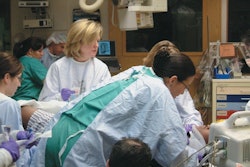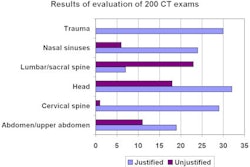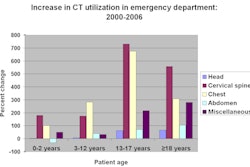In a survey evaluating the use of diagnostic imaging to rule out cervical spine injury in a 2-year-old child, 67% of emergency medicine physicians did not elect the recommended standard of care, an x-ray exam, according to an article published in Pediatric Emergency Care.
More than 55% of the survey respondents felt that a normal physical exam negated the need for diagnostic imaging confirmation. The overwhelming majority (88.7%) of respondents who elected to order a CT exam instead of a cervical spine radiograph were general emergency medicine physicians without pediatric training. A subset of this group also stated that they were uncomfortable with the examination of a young pediatric patient (May 2011, Pediatr Emerg Care, Vol. 27:5, pp. 361-366).
The article reported the outcomes of a self-reported survey sent to all 865 members of the American Academy of Pediatrics (AAP) section on pediatric emergency medicine, and 1,819 randomly selected members of the American College of Emergency Physicians (ACEP). A total of 654 out of 2,351 who successfully received the email invitation to participate responded.
The survey provided a vignette of a 2-year-old boy who'd been a passenger in a high-speed head-on auto collision. The toddler had been appropriately restrained in his car seat. In a multiple-choice format, survey recipients were asked what type of imaging, if any, they would order, and they were also asked about the reasons behind their selection.
Evidence-based guidelines recommend that cervical spine radiographs be ordered first, followed by a CT exam only if necessary to further define the extent of an injury. The thyroid in a young child under the age of 6 is exposed to 90 to 200 times more radiation from a CT exam than from a seven-view series of conventional cervical spine radiographs.
Among the 35% of physicians who would order radiographs, more than half expressed concern about radiation exposure from a CT scan, and nearly half stated that a cervical spine x-ray exam was the accepted standard of care.
Recent studies have not shown that a CT exam improves sensitivity for identifying cervical spine injuries in children as compared to radiographs, according to lead author Dr. Lorin Browne, assistant professor in the department of pediatrics section of emergency medicine at the Medical College of Wisconsin.
Failure to order an x-ray exam may represent a lack of understanding or experience with true cervical spine injuries in young children, the authors noted. While acknowledging that their study had a small sample size and might not be representative, they also expressed concern that there does not seem to be a uniformly accepted method of evaluating the pediatric cervical spine.
"Improving our knowledge and understanding of pediatric cervical spine injuries are essential to the creation of evidence-based guidelines," they wrote. "Dissemination of pediatric-specific guidelines will allow for a more standardized approach and potentially reduce unnecessary radiation exposure."



















